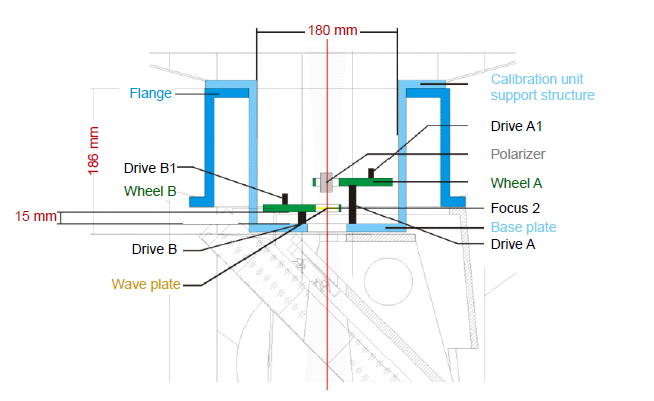
Scientists from Institute of Optics and Electronics (IOE) of the Chinese Academy of Sciences designed a polarization calibration unit for 1.8m Chinese large solar telescope (CLST), which will improve the measuring accuracy of CLST.
Recently, a research group led by RAO ChangHui, vice director and researcher of IOE, has carried out a research on polarization and calibration of the CLST's instruments and proposed a new technique approach, which effectively solves the unsynchronized problem between polarization measurement and calibration in instrument.
In addition, RAO and his team designed a new scheme to calibrate the instrument polarization in CLST dynamically, propose specific implementation requirements from the perspective of engineering application, paving the way for calibrating the polarization of the subsequent instruments in CLST.
In future, this new scheme can help to detect the high precision atmospheric polarization and magnetic field in the solar.

Fig. 1 Configuration diagram of CLST calibration unit (Image by RAO ChangHui)
Magnetic field is the main driving force of the solar storm, which is the source of space environmental disasters. Explosive solar activity such as solar proton events, coronal mass ejections and flare eruption will throw large amounts of electromagnetic radiation and particle radiation into solar-terrestrial space, deteriorating the space environment and putting a significant impact on aerospace, power electronics, human health and the Earth's climate.
An effective way to detect the magnetic field is accurately measuring the intrinsic polarization in solar atmosphere, which refers to two technologies, the high-precision polarization detection and the instrument polarization calibration.
Since the intrinsic polarization of the solar atmosphere and the instrument polarization are overlapping with each other, we cannot obtain the accurate measurement of the intrinsic polarization in solar atmosphere without high-precision, efficient separation.
Therefore, if you want to accurately measure the intrinsic polarization in solar atmosphere, first of all you need to calibrate the intrinsic polarization introduced by the solar telescope and its back-end instrument.

86-10-68597521 (day)
86-10-68597289 (night)

52 Sanlihe Rd., Xicheng District,
Beijing, China (100864)

